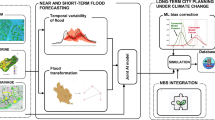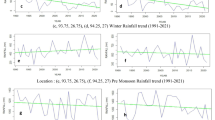Abstract
The Las Vegas Valley metropolitan area is one of the fastest growing areas in the southwestern United States. The rapid urbanization has presented many environmental challenges. For instance, as population growth and urbanization continue, the supply of sufficient clean water will become a concern. In addition, the area is also experiencing the longest drought in history, and the volume of water storage in Lake Mead, the main fresh water supply for the entire region, has been reduced greatly. The water quality in the main stem of the Las Vegas Wash (LVW) and Lake Mead may also be significantly affected. In order to develop effective sustainable management plans, the very first step is to predict the plausible future urbanization and land use patterns. This paper presents an approach to predict the future land use pattern at the LVW watershed using a Markov cellular automata model. The multi-criteria evaluation was used to couple population density as a variable depicting the driving force of urbanization in the model. Moreover, landscape metrics were used to analyze land use changes in order to better understand the dynamics of urban development in the LVW watershed. The predicted future land use maps for the years 2030 and 2050 show substantial urban development in the area, much of which are located in areas sensitive to source water protections. The results of the analysis provide valuable information for local planners and policy makers, assisting their efforts in constructing alternative sustainable urban development schemes and environmental management strategies.






Similar content being viewed by others
Abbreviations
- CA-Markov:
-
Markov cellular automata
- MCE:
-
Multi-criteria evaluation
- NLCD:
-
National Land Cover Dataset
- MRLC:
-
Multi-Resolution Land Characteristics Consortium
- PD:
-
Patch Density
- PLAND:
-
Percentage of Landscape
- SHDI:
-
Shannon’s Diversity Index
- LVW:
-
Las Vegas Wash
- LMR:
-
Little Miami River
- CDP:
-
Census Designated Place
References
Acevedo, W. (1999). Analyzing land-use change in urban environments: U.S. Geological Survey Fact Sheet (pp. 188–199).
Ahamed, T., Khan, M. I. N., Takigawa, T., Koike, M., Tasnim, F., & Zaman, J. M. Q. (2009). Resource management for sustainable development: A community and GIS-based approach. Environment, Development and Sustainability, 11, 933–954.
Bandini, S., Manzoni, S., Pavesi, G., & Simone, C. (2001). L*Mass: A language for situated multi-agent systems. Lecture Notes in Computer Science—Lecture Notes in Artificial Intelligence, 2175, 249–254.
Barredo, J. I., Kasanko, M., McCormick, N., & Lavalle, C. (2003). Modeling dynamic spatial processes; simulation of urban future scenarios through cellular automata. Landscape and Urban Planning, 64(3), 145–160.
Bell, E. J. (1974). Markov analysis of land use change—an application of stochastic processes to remotely sensed data. Socio-Economic Planning Sciences, 8, 311–316.
Buck, S., Kirk, S., Anderson, A., Brager, S., Collins, T., Sisolak, S., et al. (2009). Water Resource Plan 09. Las Vegas, NV: Southern Nevada Water Authority.
Carver, S. J. (1991). Integrating multi-criteria evaluation with geographical information systems. International Journal of Geographical Information Systems, 5(3), 321–339.
Census Bureau. (2012). United States Census Bureau. http://www.census.gov/. Accessed 1 March 2012.
Congalton, R. G. (1988). Using spatial autocorrelation analysis to explore the error in maps generated from remotely sensed data. Photogrammetric Engineering and Remote Sensing, 54, 587–592.
de Almeida, C. M., Batty, M., Monteiro, A. M. V., Camara, G., Soares-Filho, B. S., Cerqueira, G. G., et al. (2003). Stochastic cellular automata modeling of urban land use dynamics: Empirical development and estimation. Computers, Environment and Urban Systems, 27, 481–509.
Dewan, A. F., Yamaguchi, Y., & Rahman, M. Z. (2012). Dynamics of land use/cover changes and the analysis of landscape fragmentation in Dhaka metropolitan Bangladesh. GeoJournal, 77(3), 315–330.
Eastman, J. R. (2006). IDRISI Andes Tutorial. Worcester, MA: Clark Labs.
Eastman, J. R., Jin, W., Kyem, P. A. K., & Toledano, K. J. (1995). Raster procedures for multi-criteria multi-objective decisions. Photogrammetric Engineering and Remote Sensing, 61(5), 539–547.
Ghaffari, P. O., & Monavari, S. M. (2012). Physical development trend and green space destruction in developing cities: A GIS approach. Environment, Development and Sustainability. doi:10.1007/s10668-012-9381-5. http://www.springerlink.com/content/j6671k4862137724/. Accessed 29 Aug 2012.
Guan, D., Li, H., Inohae, T., Su, W., Nagaie, T., & Hokao, K. (2011). Modeling urban land use change by the integration of cellular automaton and Markov model. Ecological Modelling, 222, 3761–3772.
Guhathakurta, S., & Gober, P. (2007). The impact of the Phoenix urban heat island on residential water use. Journal of the American Planning Association, 73(3), 317–329.
He, M., & Hogue, T. S. (2012). Integrating hydrological modeling and land use projections for evaluation of hydrologic response and regional water supply in semi-arid environments. Environmental Earth Sciences, 65, 1671–1685.
IDRISI. (2012). IDRISI. Clark Lab. Clark University. http://www.clarklabs.org. Accessed 1 March 2012.
Jenerette, G. D., & Wu, J. (2001). Analysis and simulation of land-use change in the central Arizona-Phoenix region, USA. Landscape Ecology, 16, 611–626.
Jiang, H., & Eastman, R. (2000). Application of fuzzy measures in multi-criteria evaluation in GIS. International Journal of Geographical Information Science, 14(2), 173–184.
Lambin, E. F., & Geist, H. J. (2006). Land use and land cover change: Local processes and global impacts—the IGPB series. The Netherland: Springer.
Latinopoulos, D., Konstantinou, Z., & Krestenitis, Y. (2012) Simulation and multi criteria analysis in sustainable coastal planning: The case of aquaculture in Thermaikos Gulf, Greece. Environment, Development and Sustainability. doi:10.1007/s10668-012-9370-8. http://www.springerlink.com/content/x102htt755078678/. Accessed 27 June 2012.
Li, L., Sato, Y., & Zhu, H. (2003). Simulating spatial urban expansion based on a physical process. Landscape and Urban Planning, 64, 67–76.
Li, X., & Yeh, A. G. (2000). Modeling sustainable urban development by the integration of constrained cellular automata and GIS. International Journal of Geographical Information Science, 14(2), 131–152.
Liu, J., Zhan, J., & Deng, X. (2005). Spatiotemporal patterns and driving forces of urban land expansion in China during economic reform era. Ambio, 34(6), 450–455.
Lyon, J. G. (2003). GIS for water resources and watershed management. London: Taylor & Francis.
Martin, D. (1989). Mapping population data from zone centroid locations. Transactions of the Institute of British Geographers, New Series, 14(1), 90–97.
Martin, D. (1996). An assessment of surface and zonal models of population. International Journal of Geographical Information Systems, 10(8), 973–989.
Masser, I. (2001). Managing our urban future: The role of remote sensing and geographic information. Habitat International, 25, 503–512.
McGarigal, K., & Marks, B. J. (1995) FRAGSTATS: Spatial pattern analysis program for quantifying landscape structure. Portland, OR: United States Department of Agriculture, Pacific Northwest Research Station, General Technical Report PNW-GTR-351.
Mitsova, D., Shuster, W., & Wang, X. (2011). A cellular automata model of land cover change to integrate urban growth with open space conservation. Landscape and Urban Planning, 99, 141–153.
Morris, R. L., Devitt, D. A., Crites, A. M., Borden, G., & Allen, L. N. (1997). Urbanization and water conservation in Las Vegas Valley, Nevada. Journal of Water Resources Planning and Management, 123(2), 189–195.
MRLC. (2012). Multi-resolution characteristics consortium. http://www.mrlc.gov. Accessed 1 March 2012.
Ningal, T., Hartemink, A. E., & Bregt, A. K. (2008). Land use change and population growth in the Morobe Province of Papua New Guinea between 1975 and 2000. Journal of Environmental Management, 87, 117–124.
Parker, D. C., Manson, S. M., Jansen, M. A., Hoffmann, M. J., & Deadman, P. (2003). Multi-agent systems for the simulation of land use and land cover change: A review. Annals of Association of American Geographers, 93(2), 314–337.
Reginato, M., & Piechota, T. C. (2004). Nutrient contribution of nonpoint source runoff in the Las Vegas Valley. Journal of the American Water Resources Association, 40(6), 1537–1551.
Saaty, T. L. (1980). The analytical hierarchy process: Planning, priority setting, resource allocation. New York: McGraw-Hill.
Sang, L., Zhang, C., Yang, J., Zhu, D., & Yun, W. (2011). Simulation of land use spatial pattern of towns and villages based on CA-Markov model. Mathematical and Computer Modelling, 54, 938–943.
SPSS. (2012). IBM SPSS software. Predictive analytics software and solutions. http://www.spss.com. Accessed 1 March 2012.
Stave, K. A. (2003). A system dynamics model to facilitate public understanding of water management options in Las Vegas, Nevada. Journal of Environmental Management, 67, 303–313.
Tobler, W. R. (1970). A computer movie simulating urban growth in the Detroit Region. Economic Geography, 46, 234–240.
Tong, S. T. Y., & Chen, W. (2002). Modeling the relationship between land use and surface water quality. Journal of Environmental Management, 66, 377–393.
Tong, S. T. Y., Sun, Y., Ranatunga, T., He, J., & Yang, Y. J. (2011). Predicting plausible impacts of sets of climate and land use change scenarios on water resources. Applied Geography, 32, 477–489.
Tong, S. T. Y., Sun, Y., & Yang, Y. J. (2012). Generating a future land use change scenario with a modified population-coupled Markov Cellular Automata model. Journal of Environmental Informatics, 19(2), 108–119.
Wang, X., Burgess, A., & Yang, J. (2012). A scenario-based water conservation planning support system (SB-WCPSS). Stochastic Environmental Research and Risk Assessment. doi:10.1007/s00477-012-0628-3.
Weng, Q. (2002). Land use change analysis in the Zhujiang Delta of China using satellite remote sensing GIS and stochastic modeling. Journal of Environmental Management, 64, 273–284.
Wu, X., Hu, Y., He, H. S., Bu, R., Onsted, J., & Xi, F. (2009). Performance evaluation of the SLEUTH model in the Shenyang metropolitan area of northeastern China. Environmental Modeling and Assessment, 14, 221–230.
Wu, J., Jenerette, G. D., Buyantuyev, A., & Redman, C. L. (2011). Quantifying spatiotemporal patterns of urbanization: The case of the two fastest growing metropolitan region in the United States. Ecological Complexity, 8, 1–8.
Yeh, A. G., & Li, X. (1997). An integrated remote sensing and GIS approach in the monitoring and evaluation of rapid urban growth for sustainable development in the Pearl River Delta, China. International Planning studies, 2(2), 193–210.
Yeh, A. G., & Li, X. (1998). Sustainable land development model for rapid growth areas using GIS. International Journal of Geographical Information Sciences, 12(2), 169–189.
Zhang, Q., Ban, Y., Liu, J., & Hu, Y. (2011). Simulation and analysis of urban growth scenarios for the Greater Shanghai area, China. Computers, Environment and Urban Systems, 35, 126–139.
Acknowledgments
The U.S. Environmental Protection Agency partially funded the research described herein. The authors are grateful to the agency for the financial support. The manuscript has been subjected to the Agency’s administrative review and has been approved for external publication. Any opinions expressed in this paper are those of the authors and do not necessarily reflect the views of the Agency; therefore, no official endorsement should be inferred. Any mention of trade names or commercial products does not constitute endorsement or recommendation for use.
Author information
Authors and Affiliations
Corresponding author
Rights and permissions
About this article
Cite this article
Sun, Y., Tong, S.T.Y., Fang, M. et al. Exploring the effects of population growth on future land use change in the Las Vegas Wash watershed: an integrated approach of geospatial modeling and analytics. Environ Dev Sustain 15, 1495–1515 (2013). https://doi.org/10.1007/s10668-013-9447-z
Received:
Accepted:
Published:
Issue Date:
DOI: https://doi.org/10.1007/s10668-013-9447-z




